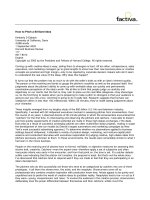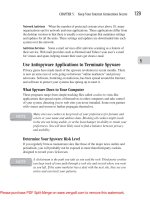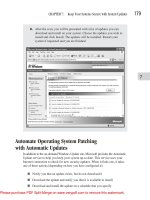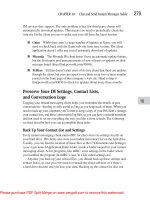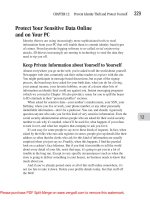Tài liệu How to do a market study doc
Bạn đang xem bản rút gọn của tài liệu. Xem và tải ngay bản đầy đủ của tài liệu tại đây (106.38 KB, 5 trang )
How to Do a Market Study
Researching markets can be awfully difficult without a good plan of action. In one of
our first tutorials we covered the important issues for doing a market study including
collecting market metrics, undertaking competitive analysis and presenting the final
report.
Nghien cuu thi truong co the het suc kho khan khi khong co mot ke hoach hanh dong
tot. Trong mot vai huong dan quan trong dau tien ma chung toi dua ra trong viec thiet
lap nghien cuu thi truong bao gom nhung thong ke co ban ve thi truong, chien luoc canh
tranh va gioi thieu nhung bao cao cuoi cung.
A Guide for Researching Markets
This tutorial provides information and guidelines that professionals and students should
consider when presented with the task of researching a market. What follows is NOT a
marketing plan. Rather what follows is a market study, a component within the larger
marketing plan. (For more information on developing a marketing plan see our
marketing plan tutorial.) Thus, the information provided should not focus so much on
what is being planned but on what has been learned about the market. However, you
can allude to what you plan to do in order to set the stage for why you are collecting
certain types of data. For example, you can say "Product X is planned to target a
specific segment of the XYZ market, consequently, we have investigated certain
aspects of this market." Those interested in following these guidelines should not limit
themselves to what is shown. Feel free to include more if it is appropriate.
The guidelines apply to almost all products and services. Additionally, these guidelines
can be adjusted in order to be used as a study of a company as a whole and not just
products/services. Please note this is an ever evolving set of guidelines
so you may want to check back on a regular basis for any updates.
This tutorial includes the following topics:
1. How to Do a Market Study
2. General Format - Parts 1-3
3. General Format - Parts 4-5
4. Competitive Analysis Guidelines
5. Presenting the Market Study
6. Other Points
General Format
1. Objective of the Research
• one paragraph explanation of why the research is being done, what you hope to
learn and for what purpose the information may be used
2. Description of the Market
• General Description - one paragraph
• Target Market(s)
o Why this particular market(s) was chosen
o Who are they - complete profile (e.g., demographics, psychographics,
behaviors)
o What benefits do they seek (i.e., what points-of-pain or problems are
being solved)
o What factors can affect their purchase or use decision
o What attitudes do they have about the products/services currently or not
currently offered
o How is the product used
• Products and Services that appeal to the target market
o In general terms (not particular brands) what is currently appealing to
this market
o If there are no current providers, what types of products/services may
appeal to this market (i.e., what is used now to solve the problem).
3. Market Metrics
• Size estimates (current and future) for:
o Overall market
Current size
Potential size
Actual penetration of current products/service within the total
market
o Individual market segments
Current size
Potential size
Actual penetration of current products/service within the total
market
o Usage rates
Frequency of product purchases
• Growth estimates (current and future) for:
o Overall market
o Individual market segments
General Format
4. Competitive Analysis
• Summary of Current Competitors
o Listing by market share ranking (by each target market if possible)
• Current Competitors - full analysis of top competitors including:
o Products & Services (e.g., description, uniqueness, pricing, etc.)
o Market share
o Current customers
o Positioning and promotion strategies
o Partnerships/Alliances/Distributors
o Recent news
o SWOT Analysis - Strengths, Weaknesses, Opportunities & Threats
It is extremely important to focus attention on the SWOT section of this report. While
most other information in this report can be gleaned from company and secondary
materials, much of what appears in the SWOT section is based on the researcher’s own
perceptions of the
competitor based on the information collected. Consequently,
this is often one of the hardest areas of the report to write.
o And other information as shown in the examples in the next section
• Potential Competitors
o Explanation (though not as detailed as Current Competitors) on who
they are or maybe and why they are seen as potential competitors
5. Additional
• Extraneous Variables
o Discuss factors that may affect this market (e.g., technological, social,
governmental, competitive, etc.)
• Market Trends
o What is expected to happen
Guidelines for Doing a Competitive Analysis
The competitive analysis section can follow a format that is shown below. In practice
we recommend this section be a single-spaced, two-column report that is limited to a
single sheet of paper (both sides used). Consequently, font size is generally 10 point or
less.
This report would be made for each of the major competitors. While most of this report
focuses on the overall analysis of the competitor, you should recognize that you are
primarily interested in how this information may impact your company and,
specifically, a product or product line. Thus, you should make sure, where possible, to
focus your information on how it impacts the markets in which your product competes.
Note each sub-section within a section will contain 1-5 sentences that explain the sub-
section.
• General Company Information - includes name, location (headquarters, other
locations of importance), website address
• Summary of Business – includes sections that summarize the company, business
units and nature of business
• Business Overview – includes sections on history, ownership structure, types of
businesses, mission, strategy/objectives, key executives
• Recent News/Developments – important company developments within last 6-
12 months (e.g., reports from news sources, press releases, financial statements)
• Financial and Market Share Analysis – includes sections on corporate
performance, trends, market share for product
• Marketing – includes sections on products and services offered, target markets,
positioning, customers/users, pricing model, promotional efforts, sales force, and
distribution
• Other Issues – includes sections on technology capability, partnership
arrangements, intangible issues
• Competitors – list key competitors facing this company
• SWOT – strengths, weaknesses, opportunities and threats
Presenting the Market Study
When a formal marketing study is to be presented in a written form we suggest the
following guidelines.
The formal document is preferably in a double-spaced format but that is not a
requirement. The plan is recommended to be delivered in a large binder and should
include the following:
• Section One - contains written report with Title Page, Table of Contents,
Executive Summary, Body of Report and Endnotes that contains full citations.
Include charts or graphs in body of document, however, if there is a page count
limit it is generally suggested only small graphics go in the main body and the rest
be placed in an Appendix section. Make sure all pages in the body are numbered.
Preferably this section can itself be bound (e.g., spiral) and inserted in the large
binder. This way just this section can be removed.
• Section Two - if needed include an Appendix for larger graphics and other
important materials such as a survey, tabulations, etc.
• Section Three - (optional) all referenced documents, websites, etc. (printed out
if possible) are included here. Try to section off these documents using tabs. For
large documents, such a large research reports, place in a folder that has holes for
the binder. For things that can’t be included, such as books, it is suggested that a
photocopy of the book’s title page, copyright page and then the page(s) from which
material is referenced.
• All Files - (optional) A storage device of some kind (e.g., floppy disk, CD,
DVD) containing the files used (e.g., word processing, spreadsheet, slides,
downloaded articles, etc.).
Other Points
• The information provided in a market study should be based on research
collected AND NOT on one’s own perceptions, guesstimates or other unsupported
statements. The only exception to this may be within the SWOT analysis, however,
even most of this should be supported with some evidence.
• If you are unable to find certain information it is probably a good idea to make
this known so the person reading the report would know of this potential limitation
of the market study. Obviously you need to collect good research so you do not
end up having too many of these statements.
• It is generally a good idea to define important terms and concepts when you first
introduce them. This will benefit those reading the report who may
not possess knowledge in this area. Alternatively, you can create a glossary
or definition section in the Endnotes area of the report.
• Where necessary explain how the research was conducted or how data was
collected (e.g., explaining how survey was done).
• Make note of any limitations of secondary research (research you obtained from
other sources) that you used. Unless there are very significant limitations you can
generally include this as an endnote.
• If you are investigating a new/different way of doing something with present
customers, then you will need to provide a discussion of the cost/benefit of
alternative options. That is, what will customer give up to use something new
versus what they will get from using the new product.
• Remember to reference as much as is needed. We recommend using endnotes
instead of footnotes. Endnotes appear next to the sentence, word, quote, number,
etc. but usually not as a superscript and usually in parenthesis like this (1). The full
reference would appear at the back of the report in an Endnotes section.

